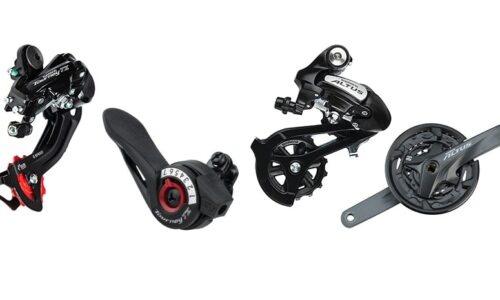The SRAM Rival and Force groupsets sit above the entry-level Apex models and below the top of the range Red groupset. The Rival and Force groupsets are available with a single or a double chainring (crankset) to suit your personal preferences.
You can also choose between different types of braking systems. This abundance of options makes it tricky to determine which groupset you should choose for your bike. To help you decide, we are going to go through each one.
SRAM RIVAL 1 vs FORCE 1
To start off with, we will compare the single chainring versions of the Rival and the Force. The advantages of a 1 x drivetrain come from the simplicity of the system.
The reasons behind this are that there is no front derailleur or shifter, you don’t get chain rub, your bike is quieter, and there is less chance of dropping the chain on bumpy terrain.
This is why you will often find this type of setup on a mountain bike or other bikes that spend a lot of time off-road.
Both the Rival and Force 1 have wide-ranging cassettes designed to be versatile enough for road and adventure riding. They are also suitable for fitness and triathlon use. It may be worth pointing out that there is currently no direct equivalent from Shimano or Campagnolo.
When it comes to changing gears, the Rival 1 is very easy to use. It features one paddle that allows you to shift up and down the entire cassette. Therefore, you quickly get used to how it shifts.
This is a similar case with the Force 1, as it also uses a single gear lever to change up and down the cassette. You may notice that shifting on these systems is not as refined as a Shimano setup, as they are a bit noisier, but they both give you precise and reliable gear changes.

The Force 1 uses an X-Sync chainring. This features tall teeth with square edges to sync with the chain better. This is a feature found on mountain bikes, as is the sharp and narrow tooth profile to help keep the chain on the ring.
Both groupsets have wide gear ranges, but the Force 1 has a broader range of chainrings to choose from.
Functionally, the Rival and Force 1 groupsets are the same, but the Rival is slightly heavier due to the materials used. For example, the Rival uses aluminum brake levers, while the Force uses carbon fiber items.
Both the Rival and Force 1 groupsets are available with hydraulic or mechanical disc brakes to suit your personal preference and budget.
Although these SRAM groupsets are designed for multiple uses, they suit adventure, touring, and cycle-cross bikes best. This is because they both have wide gaps between the gears, meaning that it is occasionally difficult to find the cadence sweet spot.
If you do opt for one of these groupsets for your road bike, you will quickly adapt to the way it feels. However, the gaps between the gears may put you off if you are a roadie that likes to keep your cadence consistent, especially if you ride changeable terrain regularly.
1x groupsets give riders another option that will suit specific niches of riding. The people who prefer them are mainly adventure riders and gravel racers who want to simplify their drivetrains and reduce the chance of mechanical failures.
Fitness riders benefit from the simplified one-handed gear shifting, and not everyone needs the full range that a 2x drivetrain offers.
Find SRAM Rival components on Amazon.com or Planetcyclery.com
SRAM RIVAL 22 vs FORCE 22
The Rival and Force 22 groupsets are very similar to the Rival and Force 1 versions. But instead of a 1x setup, these use two chainrings on the crank. The advantage of these groupsets is that you get a wider range of gears that help you keep your cadence consistent on different gradients.
The Rival 22 uses much of the technology found on the higher end SRAM Red and Force groupsets. For example, you get 22 gears, hydraulic brakes, and the ErgoFit shifter/brake lever design.
The Rival 22 groupset uses aluminum levers, rear mech cages, and cranks. These make it slightly heavier than the more expensive options but work just as well.
Sitting above the Rival 22 is the Force 22 groupset. This is widely considered to be a direct competitor to Shimano’s excellent Ultegra groupset. It also uses technology from the SRAM Red, but at a more affordable price.
This groupset is a perfect choice for racers or someone that wants to build a lightweight bike without paying top tier prices.
You can choose between hydraulic brakes for either disc brakes or rims with both groupsets. But a Rival 22 groupset equipped with hydraulic disc brakes delivers a great combination of performance and price for an all-purpose bike.
Like the 1x version, the Rival 22, the shifting is precise with a deliberate feel to the shifter, which is the same shape as the more expensive Force and Red units. Both groupsets’ shifters use SRAM’s DoubleTap system.
This works by pushing the lever once to drop down the cassette and pushing on through to shift up the cassette into easier gears.
This is an excellent system, but the Rival 22 has a slightly heavier feel than the ones on the more expensive Force 22.
It is worth noting that the Force shifters give you a similar performance level to the Red but are much more affordable. In addition to this, you get high-end items such as carbon-fiber crank arms and brake levers.
Find SRAM Force 22 components on Amazon.com
Overall
If you are considering buying a 1x groupset for road use, the Rival and Force 1 work well, but they are more suitable for riders who want a more simple drivetrain or ride rougher terrain.
You will be hard pushed to notice the difference between them in the way they operate. But if you want to shave off some grams and willing to pay the extra, the Force is the way forward.
When it comes to the 22 geared versions, the Force 22 is an excellent choice for racers or anyone wanting a light bike for fast riding. This is because the trickle-down technology from the Red justifies the extra cost.
However, you will not be disappointed with the Rival 22 groupset, especially with the available options. By carefully choosing the perfect gearing option and brake setup, you can configure the groupset to perfectly meet your requirements.

Tom Fortune has been reviewing cycling products for several years from his home in the French Alps. As the owner of mtb-threads.com, he mainly reviews mountain bike products but also reviews road cycling products independently.

![How To Use A Presta Valve Adapter [Step-by-step Guide & Video] How To Use A Presta Valve Adapter [Step-by-step Guide & Video]](https://biketestreviews.com/wp/wp-content/uploads/2023/05/howtouseaprestavalveadapter-500x300.jpg)
